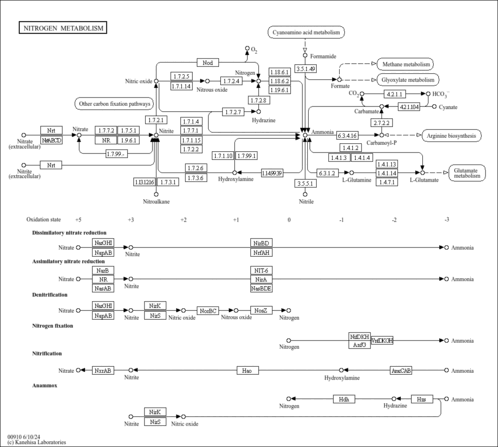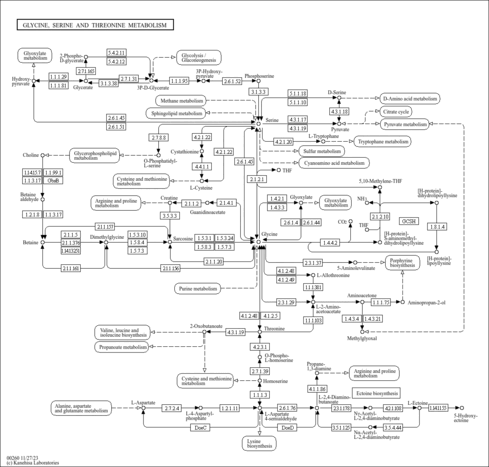| GC-MS Spectra| Spectrum Type | Description | Splash Key | Deposition Date | Source | View |
|---|
| Experimental GC-MS | GC-MS Spectrum - (R)-Lipoic acid GC-EI-TOF (Non-derivatized) | splash10-0aba-3900000000-46fc1d57abcc26f6720e | 2017-09-12 | HMDB team, MONA, MassBank | View Spectrum | | Experimental GC-MS | GC-MS Spectrum - (R)-Lipoic acid GC-EI-TOF (Non-derivatized) | splash10-0aba-3900000000-46fc1d57abcc26f6720e | 2018-05-18 | HMDB team, MONA, MassBank | View Spectrum | | Experimental GC-MS | GC-MS Spectrum - (R)-Lipoic acid GC-EI-TOF (Non-derivatized) | splash10-0aba-3900000000-46fc1d57abcc26f6720e | 2018-05-18 | HMDB team, MONA, MassBank | View Spectrum | | Experimental GC-MS | GC-MS Spectrum - (R)-Lipoic acid GC-EI-TOF (Non-derivatized) | splash10-0aba-3900000000-46fc1d57abcc26f6720e | 2018-05-18 | HMDB team, MONA, MassBank | View Spectrum | | Predicted GC-MS | Predicted GC-MS Spectrum - (R)-Lipoic acid GC-MS (Non-derivatized) - 70eV, Positive | splash10-0ufu-5900000000-716655e029db4b97efd9 | 2016-09-22 | Wishart Lab | View Spectrum | | Predicted GC-MS | Predicted GC-MS Spectrum - (R)-Lipoic acid GC-MS (1 TMS) - 70eV, Positive | splash10-0hbi-6920000000-011fb15a0f9ca4513029 | 2017-10-06 | Wishart Lab | View Spectrum | | Predicted GC-MS | Predicted GC-MS Spectrum - (R)-Lipoic acid GC-MS (Non-derivatized) - 70eV, Positive | Not Available | 2021-10-12 | Wishart Lab | View Spectrum |
MS/MS Spectra| Spectrum Type | Description | Splash Key | Deposition Date | Source | View |
|---|
| Experimental LC-MS/MS | LC-MS/MS Spectrum - (R)-Lipoic acid Quattro_QQQ 10V, Positive-QTOF (Annotated) | splash10-0a4r-0940000000-dead1b29e79e0002da2a | 2012-07-24 | HMDB team, MONA | View Spectrum | | Experimental LC-MS/MS | LC-MS/MS Spectrum - (R)-Lipoic acid Quattro_QQQ 25V, Positive-QTOF (Annotated) | splash10-0f8c-9200000000-b6035bdb4abd0d267297 | 2012-07-24 | HMDB team, MONA | View Spectrum | | Experimental LC-MS/MS | LC-MS/MS Spectrum - (R)-Lipoic acid Quattro_QQQ 40V, Positive-QTOF (Annotated) | splash10-0059-9000000000-62e73cabbac1531f5145 | 2012-07-24 | HMDB team, MONA | View Spectrum | | Experimental LC-MS/MS | LC-MS/MS Spectrum - (R)-Lipoic acid 20V, Negative-QTOF | splash10-03di-9100000000-e420d2c931e889befcfa | 2021-09-20 | HMDB team, MONA | View Spectrum | | Experimental LC-MS/MS | LC-MS/MS Spectrum - (R)-Lipoic acid 10V, Negative-QTOF | splash10-0229-6900000000-90386d8704ab5bfe8e70 | 2021-09-20 | HMDB team, MONA | View Spectrum | | Experimental LC-MS/MS | LC-MS/MS Spectrum - (R)-Lipoic acid 40V, Negative-QTOF | splash10-03di-9000000000-042d27906c9bde31821f | 2021-09-20 | HMDB team, MONA | View Spectrum | | Experimental LC-MS/MS | LC-MS/MS Spectrum - (R)-Lipoic acid 35V, Negative-QTOF | splash10-03di-9000000000-6572cec5a1c9f68d9679 | 2021-09-20 | HMDB team, MONA | View Spectrum | | Predicted LC-MS/MS | Predicted LC-MS/MS Spectrum - (R)-Lipoic acid 10V, Positive-QTOF | splash10-0a4r-0940000000-6cecd351951f396a3035 | 2016-09-12 | Wishart Lab | View Spectrum | | Predicted LC-MS/MS | Predicted LC-MS/MS Spectrum - (R)-Lipoic acid 20V, Positive-QTOF | splash10-08gr-6910000000-f169816d57d2290b0d9e | 2016-09-12 | Wishart Lab | View Spectrum | | Predicted LC-MS/MS | Predicted LC-MS/MS Spectrum - (R)-Lipoic acid 40V, Positive-QTOF | splash10-0m2c-9700000000-57ae386a681b98208a4b | 2016-09-12 | Wishart Lab | View Spectrum | | Predicted LC-MS/MS | Predicted LC-MS/MS Spectrum - (R)-Lipoic acid 10V, Negative-QTOF | splash10-0a4i-1920000000-2b265e3ed116fbc0a2ea | 2016-09-12 | Wishart Lab | View Spectrum | | Predicted LC-MS/MS | Predicted LC-MS/MS Spectrum - (R)-Lipoic acid 20V, Negative-QTOF | splash10-0ab9-2910000000-9142e84d978f4a481551 | 2016-09-12 | Wishart Lab | View Spectrum | | Predicted LC-MS/MS | Predicted LC-MS/MS Spectrum - (R)-Lipoic acid 40V, Negative-QTOF | splash10-0a4i-9200000000-8bdfe1c35977a8c80985 | 2016-09-12 | Wishart Lab | View Spectrum | | Predicted LC-MS/MS | Predicted LC-MS/MS Spectrum - (R)-Lipoic acid 10V, Positive-QTOF | splash10-0a4r-0970000000-0ae5b11a032d11c1ba6d | 2021-09-22 | Wishart Lab | View Spectrum | | Predicted LC-MS/MS | Predicted LC-MS/MS Spectrum - (R)-Lipoic acid 20V, Positive-QTOF | splash10-03di-1900000000-decf255617c1bbd69bfb | 2021-09-22 | Wishart Lab | View Spectrum | | Predicted LC-MS/MS | Predicted LC-MS/MS Spectrum - (R)-Lipoic acid 40V, Positive-QTOF | splash10-000i-6900000000-eb58a3d8135ba85d4283 | 2021-09-22 | Wishart Lab | View Spectrum | | Predicted LC-MS/MS | Predicted LC-MS/MS Spectrum - (R)-Lipoic acid 10V, Negative-QTOF | splash10-0a4i-0190000000-014d2ea36cfae0726a9e | 2021-09-23 | Wishart Lab | View Spectrum | | Predicted LC-MS/MS | Predicted LC-MS/MS Spectrum - (R)-Lipoic acid 20V, Negative-QTOF | splash10-0a4i-5950000000-4e2dd5ccdcd5b0a936a0 | 2021-09-23 | Wishart Lab | View Spectrum | | Predicted LC-MS/MS | Predicted LC-MS/MS Spectrum - (R)-Lipoic acid 40V, Negative-QTOF | splash10-0a59-9500000000-9bbbd7b252fb9a0b438d | 2021-09-23 | Wishart Lab | View Spectrum |
NMR Spectra| Spectrum Type | Description | Deposition Date | Source | View |
|---|
| Experimental 1D NMR | 1H NMR Spectrum (1D, 500 MHz, H2O, experimental) | 2012-12-04 | Wishart Lab | View Spectrum | | Experimental 2D NMR | [1H, 13C]-HSQC NMR Spectrum (2D, 600 MHz, CDCl3, experimental) | 2012-12-05 | Wishart Lab | View Spectrum |
IR Spectra| Spectrum Type | Description | Deposition Date | Source | View |
|---|
| Predicted IR Spectrum | IR Ion Spectrum (Predicted IRIS Spectrum, Adduct: [M-H]-) | 2023-02-03 | FELIX lab | View Spectrum | | Predicted IR Spectrum | IR Ion Spectrum (Predicted IRIS Spectrum, Adduct: [M+H]+) | 2023-02-03 | FELIX lab | View Spectrum | | Predicted IR Spectrum | IR Ion Spectrum (Predicted IRIS Spectrum, Adduct: [M+Na]+) | 2023-02-03 | FELIX lab | View Spectrum |
| Show more...
|---|
| General References | - Teichert J, Tuemmers T, Achenbach H, Preiss C, Hermann R, Ruus P, Preiss R: Pharmacokinetics of alpha-lipoic acid in subjects with severe kidney damage and end-stage renal disease. J Clin Pharmacol. 2005 Mar;45(3):313-28. [PubMed:15703366 ]
- Arner ES, Nordberg J, Holmgren A: Efficient reduction of lipoamide and lipoic acid by mammalian thioredoxin reductase. Biochem Biophys Res Commun. 1996 Aug 5;225(1):268-74. [PubMed:8769129 ]
- Henriksen EJ, Saengsirisuwan V: Exercise training and antioxidants: relief from oxidative stress and insulin resistance. Exerc Sport Sci Rev. 2003 Apr;31(2):79-84. [PubMed:12715971 ]
- Loginov AS, Nilova TV, Bendikov EA, Petrakov AV: [Pharmacokinetics of preparations of lipoic acid and their effect on ATP synthesis, processes of microsomal and cytosol oxidation in hepatocytes in liver damage in man]. Farmakol Toksikol. 1989 Jul-Aug;52(4):78-82. [PubMed:2509239 ]
- Baker H, Deangelis B, Baker ER, Hutner SH: A practical assay of lipoate in biologic fluids and liver in health and disease. Free Radic Biol Med. 1998 Sep;25(4-5):473-9. [PubMed:9741583 ]
- Konrad D: Utilization of the insulin-signaling network in the metabolic actions of alpha-lipoic acid-reduction or oxidation? Antioxid Redox Signal. 2005 Jul-Aug;7(7-8):1032-9. [PubMed:15998258 ]
- Bruggraber SF, Leung PS, Amano K, Quan C, Kurth MJ, Nantz MH, Benson GD, Van de Water J, Luketic V, Roche TE, Ansari AA, Coppel RL, Gershwin ME: Autoreactivity to lipoate and a conjugated form of lipoate in primary biliary cirrhosis. Gastroenterology. 2003 Dec;125(6):1705-13. [PubMed:14724823 ]
- Redden PR, Melanson RL, Douglas JA, Dick AJ: Acyloxymethyl acidic drug derivatives: in vitro hydrolytic reactivity. Int J Pharm. 1999 Apr 15;180(2):151-60. [PubMed:10370185 ]
- Tankova T, Cherninkova S, Koev D: Treatment for diabetic mononeuropathy with alpha-lipoic acid. Int J Clin Pract. 2005 Jun;59(6):645-50. [PubMed:15924591 ]
- Chevion S, Hofmann M, Ziegler R, Chevion M, Nawroth PP: The antioxidant properties of thioctic acid: characterization by cyclic voltammetry. Biochem Mol Biol Int. 1997 Feb;41(2):317-27. [PubMed:9063572 ]
- Barbiroli B, Medori R, Tritschler HJ, Klopstock T, Seibel P, Reichmann H, Iotti S, Lodi R, Zaniol P: Lipoic (thioctic) acid increases brain energy availability and skeletal muscle performance as shown by in vivo 31P-MRS in a patient with mitochondrial cytopathy. J Neurol. 1995 Jul;242(7):472-7. [PubMed:7595680 ]
- Burke DG, Chilibeck PD, Parise G, Tarnopolsky MA, Candow DG: Effect of alpha-lipoic acid combined with creatine monohydrate on human skeletal muscle creatine and phosphagen concentration. Int J Sport Nutr Exerc Metab. 2003 Sep;13(3):294-302. [PubMed:14669930 ]
- Haj-Yehia AI, Assaf P, Nassar T, Katzhendler J: Determination of lipoic acid and dihydrolipoic acid in human plasma and urine by high-performance liquid chromatography with fluorimetric detection. J Chromatogr A. 2000 Feb 18;870(1-2):381-8. [PubMed:10722093 ]
- Nagamatsu M, Nickander KK, Schmelzer JD, Raya A, Wittrock DA, Tritschler H, Low PA: Lipoic acid improves nerve blood flow, reduces oxidative stress, and improves distal nerve conduction in experimental diabetic neuropathy. Diabetes Care. 1995 Aug;18(8):1160-7. [PubMed:7587852 ]
- Steinmann B, Gitzelmann R: Strychnine treatment attempted in newborn twins with severe nonketotic hyperglycinemia. Helv Paediatr Acta. 1979;34(6):589-99. [PubMed:541222 ]
- Lee WJ, Lee IK, Kim HS, Kim YM, Koh EH, Won JC, Han SM, Kim MS, Jo I, Oh GT, Park IS, Youn JH, Park SW, Lee KU, Park JY: Alpha-lipoic acid prevents endothelial dysfunction in obese rats via activation of AMP-activated protein kinase. Arterioscler Thromb Vasc Biol. 2005 Dec;25(12):2488-94. Epub 2005 Oct 13. [PubMed:16224049 ]
- McCormick DB: A trail of research on cofactors: an odyssey with friends. J Nutr. 2000 Feb;130(2S Suppl):323S-330S. [PubMed:10721897 ]
- Semenova TV, Azhitskii GIu, Sarnatskaia VV, Nikolaev VG: [Effect of various specific agents on the heat stability of human serum albumin]. Ukr Biokhim Zh (1978). 1993 Sep-Oct;65(5):26-30. [PubMed:8160293 ]
| Show more...
|---|

